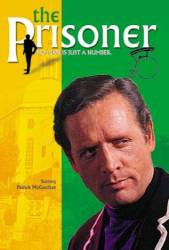A. B. and C. - S1-E3
Continuity mistake: The length of A's cigarette varies considerably between takes. It's short in long shot, then gets suddenly longer in the following close-up.
Continuity mistake: Number 6 is sitting in jail rolling a cigarette. In the long shot, you can see that he's just exhaled a cloud of cigarette smoke. But, in the next shot, he has just finished rolling the cigarette and has yet to light it. (00:11:10)
Continuity mistake: When he's trying to escape, Number 6 hides behind a bush with long narrow leaves. But when the camera angle changes to his point of view, the bush now has short broad leaves instead.
Continuity mistake: At the end of the chess match, the player wearing blue comes down off his platform, descending the ladder and walking onto the field. In the very next shot, as his opponent approaches Number 6, the man in blue is in the background, once again coming down the same ladder. He didn't have time to climb it again.
Continuity mistake: During the scene with Number 6 and the young woman in the stone boat, Number 6's jacket changes from one shot to the next. The design of the white piping is distinctively different.
Free for All - S1-E4
Visible crew/equipment: Watch the water at the lower left of the screen as Number 6 makes his speedboat escape attempt. You can see the wake created by the camera crew's boat.
Continuity mistake: During the interview, the Butler puts a coffee pitcher down beside Number 6. In the next shot, it has disappeared.
Continuity mistake: Watch the helicopter when it first lifts off. It has regular "sled-style" landing struts. But in the air, it suddenly has water pontoons. When it lands again, though, the regular struts return.
Continuity mistake: A sleeping Number 6 is being observed by the Village girl. While she watches him, his bed clothes mysteriously rearrange themselves. First they're disarrayed, then they're neatly tucked over him and his robe has moved to a different place on the bed. A few shots later, when he wakes up, his pillow disappears.
Continuity mistake: Between the time the coded note is tied to the pigeon and the time it is intercepted and handed to Number 2, the handwriting on it changes completely.
The Girl Who Was Death - S1-E15
Continuity mistake: When Number 6 is trying to stop the rocket launch, the computer console in the center is emitting smoke in close-ups, but not in long shots.
Continuity mistake: In the opening shots, the Village center is shown without the giant chessboard set up. In the very next shot, it is suddenly fully laid out on the green.
Continuity mistake: When the command "Knight to Queen's Bishop Three" is given, it's not a knight that moves, but a pawn. In the next long shot, though, Queen's Bishop Three isn't occupied by anyone, pawn or otherwise.
Continuity mistake: Number 2 sits down and places his umbrella beside him with the handle facing out. The camera angle changes, and although he hasn't touched it again, the umbrella handle is now facing inward.
Continuity mistake: When he's playing chess with The General, Number 6's jacket changes between takes. At first it has solid piping on the lapels, then the piping has gaps, then it doesn't again.
Continuity mistake: Mrs. Butterworth has a sandwich plate in her left hand and her cigarette in her right - until the shot cuts, at which point the cigarette and the sandwiches have instantly changed to the opposite hands.
Continuity mistake: In both the opening and closing sequences, as well as in footage used throughout the series, "Rover" leaves the ocean floor as a transparent sphere, but arrives on the surface colored his usual opaque white.
Continuity mistake: When he's standing against the wall of the kosho chamber, Number 6 is holding onto the rail, but when the camera reverses angles, he isn't. This goes back and forth several times.
Continuity mistake: At the final shoot-out, the Kid's hat lands and settles right next to his head after he falls. When Number 6 walks past him a few moments later, however, the hat has somehow moved itself more than a foot away.
Free for All - S1-E4
Continuity mistake: Number 6's jacket disappears between shots as he's beaten and then dragged into Number 2's office.






Answer: It's even more obvious than you think, you know who number 1 is in the very first episode. When 2 replies to the question "who is #1?" Change the way he answers from you are number one (in the monotone or accented answer to, "You are, number 6. The comma gives you the answer. #6 is #1. It's the tone of the answer.